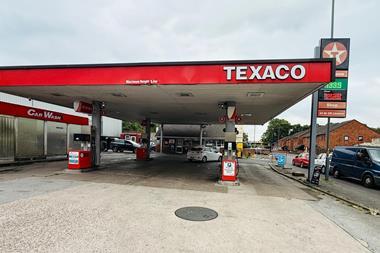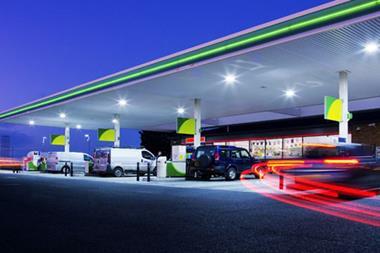I’ve only ever met one forecourt retailer who didn’t own a mobile phone. He said he didn’t need one because he was only either at home, at one of his two sites, or driving between the two. But he’s a rarity and many retailers today couldn’t survive without their smartphones as they flit from one site to another, trying to fit in a home and family life around a busy work schedule.
But with the price of fuel at such a high level, more retailers are taking a keener interest in their wet-stock management systems, and the ability to monitor stocks on the move is proving to be a particularly appealing feature.
Jonathan Tinsley, European marketing director at Gilbarco Veeder-Root, says more and more retailers are either adopting or looking to add mobile monitoring functionality to their networks. "Not only does mobile monitoring provide them with access to real-time wet-stock data, from any site, from anywhere in the world, but it is a critical tool in helping to distribute and manage alarms and sudden loss escalations," he says.
Gareth Jenkins, business account manager at Fairbanks Environmental, agrees, adding that mobile use of the Fairbanks’ website has grown considerably in the past year. The company has developed a new website (www.wetstock.mobi) that allows retailers to see their stock levels, ullage, fuel temperature and water readings on the go.
"It’s a great way of seeing how low your stock is or knowing that a delivery has just taken place," says Jenkins. "Retailers also receive vital gauge alerts straight to their mobiles so they can see what is happening on site. This could even be a ’low stock level’ alarm which will remind the retailer that an order is due before it is too late. This mobile service proved a great success during the last fuel crisis as normal sales patterns went out of the window. Retailers were checking their stocks throughout the day to monitor the situation across their networks from anywhere in the UK."
Tokheim has also been developing the online functionality of its wet-stock management solutions to help retailers manage their wet stock from a mobile device. Mike Piggot, general manager of Tokheim UK, says: "The business world is becoming increasingly mobile and Tokheim is introducing a number of new applications to our products that allow forecourt owners to manage their network from home or the office, as well as providing reports, updates and alerts to their mobile devices.
"Being browser-based, Integritas eliminates duplication and fussy paper mountains ensuring costly errors are eliminated. Real-time reports and data can be easily accessed from the office, from the home, or on the move. With password-protected level access, you decide who can view or make amendments to your system."
Real-time development
As fuel prices rise and theft is on the increase, the benefits of real-time wet-stock monitoring are becoming better understood throughout the industry so much so that real-time monitoring has now been recommended in the latest edition of the APEA Blue Book.
Says Gilbarco’s Tinsley: "With ever-increasing pressure on the finances of retail petrol forecourt operators, businesses are quickly recognising that by working to better quantify, understand and reduce their wet-stock losses, they can have a positive impact on the wet-stock margins in their business."
"A comprehensive wet-stock management system provides the retailer with visibility not only of the current levels of wet-stock inventory and reconciliation of delivered/dispensed volumes, but will also provide real-time monitoring of losses through over dispensing, theft, fraud and leakage."
The increasing pressure on the finances of forecourt operators is also driving the trend towards closer management of dispensed fuel volumes. A recent study by Gilbarco Veeder-Root found that for a ’typical’ retailer with a well-regulated network, for every 100 dispenser meters that were dispensing incorrectly, 97 were over-dispensing and three were under-dispensing.
"To combat this, retailers can now look to real-time meter monitoring technology to help them maintain meter accuracy and safeguard fuel profitability by proactively discovering and preventing over-dispensing," says Tinsley. "The same technology also has the benefit of detecting under-dispensing to protect retailers against the possibility of non-compliance with weights and measures regulations."
In addition, real-time monitoring is probably the best solution for retailers who have adopted Automatic Temperature Compensation (ATC) or moved to new supply agreements based on Standard Temperature Accounting (STA) to maximise fuel margins. According to Phil Prow, marketing director at Vianet Fuel Solutions, the traditional approach to wet stock a daily reconciliation process that may be enhanced with a third-party SIR (statistical inventory reconciliation) service is not able to give retailers the information they really need to manage and control ATC or STA.
"If retailers have ATC, they should be aware that traditional SIR will not be able to discern potential line leaks, as the gains they see in the daily reconciliation caused by ATC could mask other wet-stock problems such as these," he says. "The solution is to move to a real-time wet-stock management service.
"Real-time monitoring also provides the ability to have a much better delivery reconciliation process, so retailers can ensure they are paying the right amount for their delivery," adds Prow.
"If retailers have an STA supply agreement, the actual amount they pay can vary by hundreds of pounds per delivery, depending on the temperature that has been used to calculate the compensated amount.
"Again, real-time monitoring gives the retailer the opportunity to reconcile the gross amount of the delivery versus the compensated amount.
"Real-time monitoring can do this because it calculates the temperature of the delivered volume into the site. In addition, the forecourt sector has seen a rise in bulk fuel theft, and real-time monitoring can help with this by sending out alarms within minutes of a bulk theft occurring."
With the advent of cheaper, faster broadband and VFS’s new Clearview software that can interface with most forecourt equipment real-time monitoring has never been more available or affordable, adds Prow.
"The future is real-time stock monitoring which, coupled with regular pump calibration, is the only way of maximising the profit margin on every drop, which is why we are recommending this system to all retailers.
"Traditionally retailers accepted losses of 0.3% or more, but with the implementation of the right supply agreement for your site ATC and rigorous meter checking all controlled by a real-time monitoring system, then these losses can be reduced significantly."
Fairbanks’ Jenkins agrees that the analysis and understanding of fuel temperature data has grown in importance over the past year. "Retailers are increasingly being faced with key decisions about which fuel agreement they should take or what type of fuel pump they should install," he says. "The common factor here is the temperature of the fuel underground and what impact this has on profit and loss each month."
Fairbanks has developed a series of new reports that use historical sales and temperature data collected from the tank probe and report this back to the retailer. "This new insight has already made a difference to hundreds of forecourts," says Jenkins. "By understanding if a new STA fuel agreement or ATC pump is a benefit to your forecourt then you will have an advantage over your competition."
Best practice
Gilbarco’s Jonathan Tinsley says that many retailers are not paying enough attention to accurate tank calibration. "Managing wet-stock losses and explaining daily variances is a constant battle," he says.
"These variances can be due to the effect of temperature, delivery or unexplained loss. Worryingly, the true impact of these causes of periodic wet-stock losses can be easily masked by calibration errors, yet many forecourt operators still don’t give accurate tank calibration the focus it deserves."
Tinsley says that for Automatic Tank Gauge systems (ATGs) to be of real value, the tank calibration must be as accurate as possible, but many factors make accurate tank calibration data difficult to obtain. "The reasons for this are many all tanks vary in shape and the way in which they’ve been installed (on a slope, with a slight lateral role, with distortion, with differing ATG probe locations)," he says.
"Existing tanks may have been in the ground for a long time and may have limited data available or have been impacted by any number of environmental factors such as a shift in the surrounding terrain. New tanks are better but are still subject to the effects of calibration accuracy.
"Fortunately, new Off Site Calibration (OSC) services are now available to fuel retailers that use a combination of bespoke software programs and expert analysts to understand where the errors are in the calibration tables, and correct them accordingly."
Meanwhile, Tokheim’s Integritas range offers a variety of systems including entry-level probes, tank gauge consoles, and head-office wet-stock management packages to meet every budget. Adrian Beeby, the company’s UK sales manager, says: "Some clients simply want a probe to monitor tank levels and we have a system for that; others want a gauge that provides inventory management and leak detection, and we have a system for that; larger forecourt businesses wish to have line leak and wet-stock management for up to 72 tanks, we have a system for them too."
Tokheim’s FuelPOS point-of-sale system incorporates wet-stock management features designed for the world’s largest oil companies and is now available to all petrol station managers in the UK.
Connecting the FuelPOS to a level gauge probe provides the total wet-stock solution, including complete integrated temperature compensated stock reconciliation, static and dynamic leak detection, automatic tank calibration, tank alerts and complete reporting.
Finally, Petrol Manager allows for remote management of a network of sites. "It provides service stations with simple but powerful tools to manage sales, pricing, alerts and improve their wet-stock efficiencies," says Beeby.
"Fuel retailers should be aware of how their wet-stock systems may be affected by recently introduced legislation such as vapour recovery. For example, vapour recovery solutions affect the pressure in your tank, making ordinary hydrostatic gauges inaccurate. However an electronic tank gauge system from Tokheim retains its accuracy."
Tokheim also provides density measurement capabilities for fuel retailers, which lets the retailer know if they have taken either the wrong product in the tank (diesel instead of unleaded) or whether the quality of the fuel is sub-standard. "We provide a density measurement float kit, which can be used to continuously monitor the density of fuel stored in underground and above-ground storage tanks.
"This valuable option can be used to validate the consistency of fuel drops from suppliers and to alert the user of potentially hazardous misdeliveries to the wrong tank. In addition, density measurement floats are supported by the Integritas systems. These can be set up to notify the user of density alarms in a variety of ways, including printing or emailing notifications, sounding internal or external horns, and/or disabling the pump."
New development
Meanwhile, a new Digital Statistical Inventory Reconciliation Analysis (digital SIRA) leak detection services are now available from Pinnacle Monitoring. The digital systems have been developed using new technology computer software from scratch rather than developing any existing systems, and are said to be designed with the greatest of flexibility to ensure that service levels are delivered within the retailer’s existing systems.
The company says that all the functions of the Pinnacle Monitoring digital SIRA are controlled employing new technology. Input can be digital or analogue, received via email, file transfer or direct feed thus not restricting anyone from having the new digital SIRA service and having an advanced Digital SIRA leak detection service that can offer additional features to ensure improved performance.
dealing with losses
l If you suspect a tank is leaking, stop taking deliveries immediately.
l Check pump meters to make sure the pumps are not over-vending. Similarly, an under-dispensing pump could be disguising a leak.
l If the pump meter proves to be on strike, contract a precision tank-testing company to test the tank and pipework.
l Retailers who are using daily tank dip readings for stock reconciliation should cover themselves against losses by having regular tank tests.
l If there is no indication of water leaking in in the form of customer complaints or tank gauge alarms continue to sell the remaining fuel in the tank. If there is a leak, the more fuel that is sold, the less head pressure of fuel will be in the tank and therefore there is likely to be less fuel lost into the ground.
l Remember that to rely on wet-stock loss data alone is not a guarantee your underground fuel system is leak-free. If your site has a remote/off-set fill, small leaks between the tanker connection and the tank may go unnoticed written off as short deliveries, vapour loss or temperature shrinkage in hot product terminal areas.
l Annual testing of remote/off-set fills are recommended, particularly for high-volume sites. This can be done during the annual Stage 1B vapour recovery inspection.
l Ensure that poppet valves are not fitted inside the suction lines at your sites. If poppet valves are in place inside the tank manholes, they allow pipelines to stay full of fuel, even when there is a leak. Small pipework leaks can go undetected for years, causing serious site contamination if not discovered. All suction lines should be fitted with under pump valves, which drain the lines back to the tank in the event of a leak.
l Pressure lines must have electronic or mechanical leak detection within submersible pumps if the pipework is single wall. Double-wall pipework is highly recommended with pressure pipework systems so that leaks drain back to the tank manholes.
l Always investigate water alarms by dipping the tank to confirm the presence of water. Minimise the risk of vehicle breakdowns by shutting nozzles immediately until the water alarm has been fully resolved.
l Get advice. Tank contractors have learnt from other retailers’ bad experiences, so pick up the phone and ask for help advice is always free!
Source: Eurotank Environmental
Choosing the right service
Retailers can gain a great deal of knowledge, assurance and understanding about their forecourt from a wet-stock management system, says Gareth Jenkins, business account manager at Fairbanks Environmental. "But the key to first entering into a new agreement with a service provider is ensuring they meet your needs and can fit in with what your business wants," he says. "So our advice would be to consider your biggest concerns about the running of your site, and consider how much this is costing your business in time and effort. By understanding your needs then you will be better placed to get the most out of a new service to improve your business."
Jenkins says retailers need to ask themselves the following questions:
l Is accurate monthly data the most important aspect?
l Do you need a third-party system to comply with regulations and satisfy the Petroleum Officer?
l Have you had a leak and do you want to avoid this costly experience from happening again?
l Do you worry that your site staff are not understanding the data and wouldn’t know what to do if a problem arose?
l Is it real-time data that is the key to running your business?
l Is theft by staff or uplifts from the tanks at night your biggest concern?
l Would stock data help you when ordering fuel from the office or at home?


























No comments yet